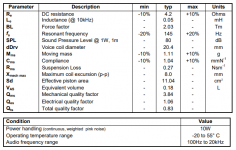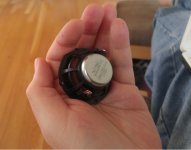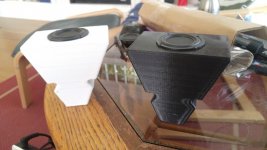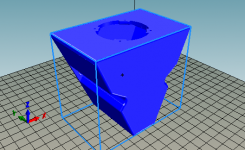Old thread, I know.
But does anyone have an educated guess what the power handling (as little as that probably means ) would be on the TEBM35C10 if used only above, say, 1kHz? Is the power limit due to excursion capability or thermal, or something more insidious?
) would be on the TEBM35C10 if used only above, say, 1kHz? Is the power limit due to excursion capability or thermal, or something more insidious?

Interested in this as a possible ambience tweeter because of it's wider than usual HF radiation pattern. And because of size and price.
Thanks
But does anyone have an educated guess what the power handling (as little as that probably means
Interested in this as a possible ambience tweeter because of it's wider than usual HF radiation pattern. And because of size and price.
Thanks
Attachments
Hello Bill.
I have done some testing with this little one in the past.
They sound horribly distorted under 400Hz, but very nice above that. If you were to use them from 1kHz and up, I'm sure they could take some heat, at least more than the rated 10W... Also, being so small, they are not well ventilated, but since you are not using them anywhere bass range, it should be fine.
I used a 4th order at 500Hz and I was able to get some spl by pushing them a bit. They are not meant to be loud, but as ambience tweeter, they should do fine indeed.
I have done some testing with this little one in the past.
They sound horribly distorted under 400Hz, but very nice above that. If you were to use them from 1kHz and up, I'm sure they could take some heat, at least more than the rated 10W... Also, being so small, they are not well ventilated, but since you are not using them anywhere bass range, it should be fine.
I used a 4th order at 500Hz and I was able to get some spl by pushing them a bit. They are not meant to be loud, but as ambience tweeter, they should do fine indeed.
This is making me a bit curious, what are the plans for the ambience tweeters?
Glad you asked, so you get a long expanation! So here's the idea:
My living room (main floor of house) is quite small, but it's the most comfortable room in the house and where I mostly hang out. I have a 'listening area' in the basement, but it's a basement, it's dark, it's too close to the noise furnace/Air conditioning unit, and isolated away from my wife. So I've been concentrating on improving the listening situation in the living room.
The only practical way to arrange speakers in here (and that would also satisfy my wife's preference for room arrangement) is with speakers in the long wall. But in that arrangement, the speakers have to be right against the wall, particularly if the listening seats are going to have any space behind them to that wall back there. Dipoles or speakers that need space behind them to sound even passable aren't an option. So, I've taken that as a challenge to get something that fits in there and works well against the wall. Something small is a plus, both to not dominate the room visually and to keep the wife happy. And keeps me out of the competitions for speaker designs that might be the 'best there could be under any impractical conditions in a room no one would want to spend much time in' type of thing that seems pretty well covered already.
So, I've come up with miniaturized Synergy/Unity type waveguide speakers (the SmallSyns, documented elsewhere on this forum), which are great with handling energy off side walls and giving good overall performance. Those of you've who've built or heard well-implemented Synergy horns know how well they produce a sound field that doesn't seem to come out of the speakers but somehow just from an area -- it really takes some effort to convince a listener or even myself sometimes that the sound is actually coming from the two speakers. They even give a good sense of depth to the sound, at least compared to what I'd get with regular cone-and-dome speakers placed there.
But Synergy horns in a small room can get sort of like headphones in sound. The sound is super clear with precise location, etc., etc., but missing much of the impression that one is actually in a room where the music is being performed -- it's more like the front wall has a big opening and there are people playing in the next room there. Directivity has many benefits, but a few complications as well. Nice, but could be better. The against-the-wall positioning has definite advantages for bass response (helps minimize baffle step), but I don't get the ambience from delayed reflection off the front wall that other systems get by having speakers stuck out a meter or more from that wall. In the basement system, I have big diffusers set up behind and to the sides to gather delayed wavefronts and send them back to the seat with very good effect, but that's not an option in our living room.
So I was thinking that I could add a simulated delayed reflection, from the front (for compactness) through use of some spare channels in the MiniDSP 2x4HD I have. Put some drivers behind the speaker and against the wall, firing upward and to the side and feed them with time-diffused signal that is also delayed about 10 to 20msec. The precise sound of the Synergies shouldn't be bothered since the added signal will be out of the initial audible integration period, yet not so late as to sound like echo. The 2x4HD has FIR filters, so I can make the ambience drivers' phase response at HF quite scrambled for the desired diffuse effect without bothering imaging or tonality.
As further justification (I'm not sure about this part, but it's somewhere to start), I can use the arrangement to equalize the power response to match the on-axis response if the energy I feed to the ambience drivers is tipped toward frequencies where directivity of the speakers is higher. Even constant directivity conical horns like SmallSyns still have coverage that narrows at higher frequencies. I did some measurement and spreadsheet math and it appears that with my speakers that would happen if the ambience drivers covered mostly 2kHz and up, played about 5 or 6dB below the Synergy speaker levels.
So, that's where I got to the idea of some minature BMRs playing at upper mid to HF. An idea not too much different than Linkwitz does in his recent dipole speakers or that Audiokinesis (Duke LeJeune) does with his "LCS" floor-mount ambience speakers. Duke's run full-range (I think), though. Mine will have the flexibility to add further DSP delay and time diffusion so that any energy that does arrive at the seat directly from the ambience drivers shouldn't disturb any of the clarity of the SmallSyns. It will take a few more amplifier channels, but really, decent class D amplification is so cheap and small now that amps aren't an issue.
If I really can get away with doing this only at HF (it's largely HF shimmer that seems to be lacking) then maybe I can use use open baffle for the BMRs -- have them firing both up and down, rather than waste the energy from the back of the drivers. If not, I've 3D printed some small wedge-shaped enclouser that could get them playing down at least to the mid-hundreds of Hz.
BMR drivers should come in sometime this week and I've got two of the wedge shaped enclosures ready so some first preview tests shouldn't be too far off.
(I've had some experience with Dolby surround, and simulated acoustic from back channels. It wasn't a great effect then, but I'm hoping this will do better. The surround channels had the problem of being too locate-able, at least when one was walking through the room, which for me spoils the illusion even after I'm seated. Hoping that stuffing the sound sources at the front and all behind the SmallSyns will avoid that).
Maybe use open baffle? It wd help with the low sensitivity
Do you mean because there's be ambient radiation from both front and back? If decorrelated, that should give about 3dB more energy in the room?
If I can get by with keeping the BMRs acting as tweeters, that should work. But if they have to go lower than enclosures would be needed I think. But for 'open baffles', the BMRs might be mounted with simple "L bracket" type structures to screw onto the backs of the SmallSyns. Certainly would be easier to implement.
I tried my little BMRs on OB and it was not great. Might have been because of their very wide dispersion. They had the best sound when mounted in an small enclosure. Maybe the fact that you will run them for HF only might be better.... but still unsure. You'll see/hear for yourself.
I played around with BMR's and used XRK's foam core enclosure that was front ported....Although they sounded decent you cant change physics as a 2 inch driver will always sound small/tiny.
If you like the sound of BMR drivers but want a larger fuller sounding speaker then DML panels is the way to go.
If you like the sound of BMR drivers but want a larger fuller sounding speaker then DML panels is the way to go.
About setting a Tectonic BMR in open baffle, I don't think it is worthwhile. Backside shows just the spider and large magnet. Some sound radiating out yes but ...
Preferably two units back to back and you can also play with polarity flip. Because of alignment difference, there will always be haphazard nulls, but they are difficult to hear becaus reflections from the front wall are mixing in anyway. More ambience effect resulting, yes!.
Preferably two units back to back and you can also play with polarity flip. Because of alignment difference, there will always be haphazard nulls, but they are difficult to hear becaus reflections from the front wall are mixing in anyway. More ambience effect resulting, yes!.
An externally hosted image should be here but it was not working when we last tested it.
Hope to read about your experiments soon, bwaslo.
I have virtual sources behind the listening position, reflecting of close by side objects.
This makes them arrive laterally at the sweet spot.
They are lowpassed at ~3500 Hz though, else I could hear them separately.
I've always wanted to try running up to higher frequencies coming from the front. Never got around to it, partly because I wouldn't know where to hide them from the wife if I liked it too much.
I have virtual sources behind the listening position, reflecting of close by side objects.
This makes them arrive laterally at the sweet spot.
They are lowpassed at ~3500 Hz though, else I could hear them separately.
I've always wanted to try running up to higher frequencies coming from the front. Never got around to it, partly because I wouldn't know where to hide them from the wife if I liked it too much.
Getting there. The BMR drivers came in and I 3D printed a few little enclosures for them to try out, maybe later today. A printed box is about the only practical way to mount these little suckers if you plan to use the tiny mounting holes, the cutout is pretty complex and not much room for error. Of course, if you plan to use wood and construct by hand, you could just cut a 46.5mm dia hole and use silicone glue to mount the driver, but the mounting holes wouldn't be usable since the holes are on a diameter of only about 47.5mm! The screw sizes, btw, would be either M2 or #2 self-tapping type. About the same size as the screws that hold remote control units together. I got some on order from ebay.
These things are TINY, here is one in my not-particularly-large hand:

These are two enclosures I made to test it out. The black one was supposed to be a revised version (different side mounting slots), but I managed to choose the older file instead when I went to print last night
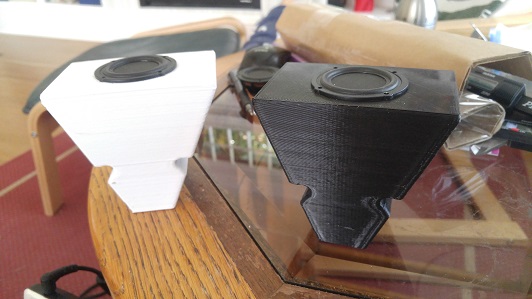
The plan (if this works out) is to have 4 of these per side mounted to the back of each speaker, firing upward and toward the sides. With one each, I don't expect to get much volume from them -- not sure I'll get enough with 4 each for that matter! Hoping that running them with a highpass will let me drive them a little harder.
This is what the 'revised' version looks like. Mostly just moved the mountings more toward the fronts and changed some angles/slopes to make things easier for the 3D printer.

These things are TINY, here is one in my not-particularly-large hand:
These are two enclosures I made to test it out. The black one was supposed to be a revised version (different side mounting slots), but I managed to choose the older file instead when I went to print last night
The plan (if this works out) is to have 4 of these per side mounted to the back of each speaker, firing upward and toward the sides. With one each, I don't expect to get much volume from them -- not sure I'll get enough with 4 each for that matter! Hoping that running them with a highpass will let me drive them a little harder.
This is what the 'revised' version looks like. Mostly just moved the mountings more toward the fronts and changed some angles/slopes to make things easier for the 3D printer.
Attachments
Last edited:
I've screwed around with Ambiophonics. The fundamental problem that I ran into was that the processing nukes the bass and the dynamics. This is because the processing adds an inverted signal to cancel crosstalk, and while the inverted signal widens the stage dramatically, it also kills bass and dynamics.
One day, on a lark, I had an idea:
What if you put the crosstalk cancellation speakers NEAR THE LISTENER?
So the speakers are on the other side of the room, and the crosstalk cancellation speakers are near the listening chair.

Imagine a Polk SDA where you took the 'cancellation' speakers, removed them from the box, put them near the listener, then time aligned the signals to compensate for the pathlength difference.
Obviously, this only works for a single seat. But it worked astonishingly well for me, way better than any of my ambio experiments.
I wound up abandoning the project, because I'm totally ADHD, but it definitely worked.
It wasn't 100% great; for instance I found that on a lot of recordings the effect was TOO dramatic. It's jarring to have a soundstage that seems to encompass the entire room. Fun in small doses, a bit exhausting after a while. But that's easily addressed with a simple volume knob on the 'crosstalk cancellation speakers'.
I wrote it up here:
Crazy Wide Soundstage - Car Audio | DiyMobileAudio.com | Car Stereo Forum
One day, on a lark, I had an idea:
What if you put the crosstalk cancellation speakers NEAR THE LISTENER?
So the speakers are on the other side of the room, and the crosstalk cancellation speakers are near the listening chair.

Imagine a Polk SDA where you took the 'cancellation' speakers, removed them from the box, put them near the listener, then time aligned the signals to compensate for the pathlength difference.
Obviously, this only works for a single seat. But it worked astonishingly well for me, way better than any of my ambio experiments.
I wound up abandoning the project, because I'm totally ADHD, but it definitely worked.
It wasn't 100% great; for instance I found that on a lot of recordings the effect was TOO dramatic. It's jarring to have a soundstage that seems to encompass the entire room. Fun in small doses, a bit exhausting after a while. But that's easily addressed with a simple volume knob on the 'crosstalk cancellation speakers'.
I wrote it up here:
Crazy Wide Soundstage - Car Audio | DiyMobileAudio.com | Car Stereo Forum
I don't think that would work for me (even if I had a place near the seat for yet more speakers!). I'm really bugged if when I move around (or go into/out of a room) and the sound image swoops around dramatically. That was the main failing for me when I used synthesized back channels with an old dolby setup. Even if it worked when I was seated, the experience of having strongly localized speakers heard with normal living movement was still enough to continually emphasize the fake-ness of it all.
Well, so far so good. I should probably start a separate thread about this, over at multiway.... When I get further along.
The single driver actually seems to do pretty well. Seems to work best so far crossed in about 1700Hz, playing about 4 or 5 dB below the mains. I don't have the FIR phase scrambling in, yet, that will take some more work. I also haven't measured anything yet. Delay sounds best around 15msec (WAY more depth to the sound field, but the ms value doesn't seem touchy). Over 25msec starts to sound too thick, under 5msec affects the tonality more (at least when the BMR is crossed in lower in frequency).
Oddly, it makes it easier to differentiate instruments and voices. Maybe that's just from more treble info in the room. Hard to say. I have to say it does sound much better to my ears so far. Turning off the ambience field brings on actual disappointment, don't want to leave it off. So I'm going to go forward and print out 8 of the enclosures.
Patrick's mention of crossing the channels gave me something that was easily tried, and it does seem to make the room fill more. Having the BMRs at back of the SmallSyns does well at preventing any speaker localization. If I had a way to wire them and make them look good, I'd consider putting some 'wall sconce' sets up in the far edges of the room, though that might still cause the sound field to shift too noticably when moving in the room.
The single driver actually seems to do pretty well. Seems to work best so far crossed in about 1700Hz, playing about 4 or 5 dB below the mains. I don't have the FIR phase scrambling in, yet, that will take some more work. I also haven't measured anything yet. Delay sounds best around 15msec (WAY more depth to the sound field, but the ms value doesn't seem touchy). Over 25msec starts to sound too thick, under 5msec affects the tonality more (at least when the BMR is crossed in lower in frequency).
Oddly, it makes it easier to differentiate instruments and voices. Maybe that's just from more treble info in the room. Hard to say. I have to say it does sound much better to my ears so far. Turning off the ambience field brings on actual disappointment, don't want to leave it off. So I'm going to go forward and print out 8 of the enclosures.
Patrick's mention of crossing the channels gave me something that was easily tried, and it does seem to make the room fill more. Having the BMRs at back of the SmallSyns does well at preventing any speaker localization. If I had a way to wire them and make them look good, I'd consider putting some 'wall sconce' sets up in the far edges of the room, though that might still cause the sound field to shift too noticably when moving in the room.
That's so cool!
Linkwitz Orions beaten by Behringer.... what!!?
About a decade ago, there was a thread about the Linkwitz Orions being beaten by a cheap Behringer speaker. But the curious part, which no one seemed to notice, is that they were BOTH beaten by a speaker inspired by the Bose 901.
That got me tinkering with speakers that are intentionally designed to create reflections. And one of the curious results was that it DID seem to do things that were counterintuitive. For instance, you would expect that intelligibility would be terrible. But instead, it was improved.
My 'hunch' on why this happens is The Precedence Effect. Basically a conventional loudspeaker has a handful of strong reflections. (Ceiling, floor, side walls.) But a speaker with numerous arrivals, will have a confusing series of audible cues.
My 'hunch' is that our brains isolate the first arrival and discard the plethora of late arrivals, similar to how we can understand a conversation in a 'live' room, but a recording of a 'live' room is unintelligible.
With a small series of strong reflections, the brain is confused, trying to determine which signal is the most important.
Or at least that's my theory.
Linkwitz Orions beaten by Behringer.... what!!?
About a decade ago, there was a thread about the Linkwitz Orions being beaten by a cheap Behringer speaker. But the curious part, which no one seemed to notice, is that they were BOTH beaten by a speaker inspired by the Bose 901.
That got me tinkering with speakers that are intentionally designed to create reflections. And one of the curious results was that it DID seem to do things that were counterintuitive. For instance, you would expect that intelligibility would be terrible. But instead, it was improved.
My 'hunch' on why this happens is The Precedence Effect. Basically a conventional loudspeaker has a handful of strong reflections. (Ceiling, floor, side walls.) But a speaker with numerous arrivals, will have a confusing series of audible cues.
My 'hunch' is that our brains isolate the first arrival and discard the plethora of late arrivals, similar to how we can understand a conversation in a 'live' room, but a recording of a 'live' room is unintelligible.
With a small series of strong reflections, the brain is confused, trying to determine which signal is the most important.
Or at least that's my theory.
I think that's on the right track. My guess is that two speakers cause relatively few reflections, all of which make the positions easy to locate, and make clues about how far away the speakers are, hurting the depth illusion. Controlled directivity cuts some early reflections and making more long-path delayed reflections. So more relections of various (and longer) delays helps disguise the fact that there are only two spot channels producinf it all.
I'm also of the opinion that the directions of sounds matters a lot, even more than frequency response. Natural sound doesn't come from just two spots in front of you, if the instruments are spread out in a room you are also in. Even contrived sounds from other directions (but delayed enough to not mess up the precedence effect or get into the tonality integration time) are still more "accurate" than sounds that come only from two spots. Particularly if those spors are different for different frequency ranges.
Of course that's just my theory at the moment, likely to be modified or even change entirely in the future!
I'm also of the opinion that the directions of sounds matters a lot, even more than frequency response. Natural sound doesn't come from just two spots in front of you, if the instruments are spread out in a room you are also in. Even contrived sounds from other directions (but delayed enough to not mess up the precedence effect or get into the tonality integration time) are still more "accurate" than sounds that come only from two spots. Particularly if those spors are different for different frequency ranges.
Of course that's just my theory at the moment, likely to be modified or even change entirely in the future!
Natural sound doesn't come from just two spots in front of you, ...!
That’s why I love my OB setup so much.
When dealing with most speakers, the music seems “projected” to my head, but with my OBs, it radiates to me, which I find more pleasing.
I know it’s not for everyone, but it works for me.
I agree with perceval
Sort of tour de force to use highly directive synergys as mains and then do dsp tricks/spatial enhancement with additional ambience speakers! But still, this is a very interesting topic and bwaslo can write excellent reports of his experiments.
My living room system has a AV receiver as preamp and I can listen to 2.0 stereo or 5.0 Dolby ProLogicII processed sound too. Now with dipoles I don't use processing any more for music, but do listen DD multichannel for movies and TV.
Sort of tour de force to use highly directive synergys as mains and then do dsp tricks/spatial enhancement with additional ambience speakers! But still, this is a very interesting topic and bwaslo can write excellent reports of his experiments.
My living room system has a AV receiver as preamp and I can listen to 2.0 stereo or 5.0 Dolby ProLogicII processed sound too. Now with dipoles I don't use processing any more for music, but do listen DD multichannel for movies and TV.
To end this threadjack, my yammerings (a lot copied from here) are moved to
- Status
- This old topic is closed. If you want to reopen this topic, contact a moderator using the "Report Post" button.
- Home
- Loudspeakers
- Full Range
- Trials with the little Tectonic BMR 2"
